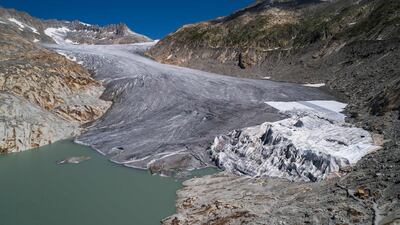The mighty glacier known as Aletsch, the largest in the Swiss Alps, could completely disappear by the end of this century if nothing is done to rein in climate change, a study published on Thursday said.
A team of researchers in Switzerland used a simulation to show how the Aletsch Glacier would change as the planet continued to warm, the ETH technical university in Zurich said.
The glacier, which covers 86 square kilometres and is estimated to hold about 11 billion tonnes of ice, has already had its tongue recede by about a kilometre since the turn of the century.
Scientists are predicting that trend will continue even if the world is able to meet the 2015 Paris Agreement target of capping global warming at less than 2°C above pre-industrial times.
The ETH research team said that even in the best-case scenario, the glacier would lose half of its volume and length by 2100, while in the worst case, "a couple patches of ice will be all that's left."
Aletsch is one of more than 4,000 glaciers dotted throughout the Alps, providing seasonal water to millions and forming some of Europe's most stunning landscapes.
In a study this year, ETH researchers determined that more than 90 per cent of those glaciers would disappear by 2100 if greenhouse gas emissions are left unchecked.
Thursday's study focused specifically on the biggest glacier of them all.
Guillaume Jouvet and Matthias Huss at ETH's laboratory of glaciology applied 3D model simulations for the ice retreat using different established climate scenarios for Switzerland.
They show the glacier seen from the Eggishorn and Jungfraujoch peaks, which tower 2,927 and 3,466 metres above sea level, as it rapidly recedes over the next 80 years.
They focused on three scenarios determined by different concentrations of carbon dioxide in the atmosphere, thus different levels of global warming.
Even if warming is limited to below 2°C and the climate is stabilised by 2040, "we have to assume that the Aletsch Glacier will keep retreating until the end of the century", Mr Jouvet said.
He said that large glaciers were very slow to react to climate change.
"This means both ice volume and length will be reduced by more than half of what they are today," Mr Jouvet said.
If the global community is unable to pull together and limit the planet-warming gases emitted through burning fossil fuels, construction, aviation and farming, the situation for the glacier will be "much more critical", ETH said.
If Switzerland's climate warms by between 4°C and 8°C by 2100 – an "unfavourable but unfortunately fully realistic scenario" – only "a couple of measly patches of ice" will remain.
And Konkordiaplatz, which is directly below Jungfraujoch and still covered in about 800 metres of ice, will be completely ice-free, Mr Jouvet said.


